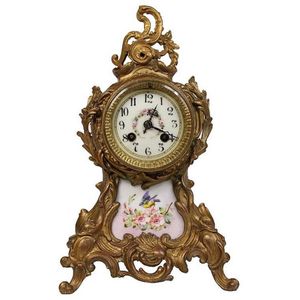French Boulle Clock by Planchon Au Palais Royal
You must be a subscriber, and be logged in to view price and dealer details.
Subscribe Now to view actual auction price for this item
When you subscribe, you have the option of setting the currency in which to display prices to $Au, $US, $NZ or Stg.
- Acanthus - A stylized leaf motif, one of the primary decorative elements of classical Greek and Roman architecture, derived from the genus of flowering plants in the family Acanthaceae, native to tropical and subtropical regions of the Mediterranean area. It is a common element in classical Greek and Roman design, and is often seen in Corinthian and Composite order columns and used as a decorative element in English, European and Australian furniture, particularly on the curve of a leg, and as decoration for a corbel.
- Boulle - Boulle work is the name given to tortoiseshell and metal inlay using brass and sometimes silver, found on furniture and smaller wooden objects. It originated in Italy but was developed by Frenchman Andre Charles Boulle (1642 - 1732) under Louis XIV.
Boulle was appointed Royal Cainet Maker to Louis XIV and designed furniture and clockcases for the monarch.
In preparation, the tortoiseshell and metal were cut together following a design, using a fine fret saw.
In the application of the Boulle, the carcase of piece of furniture was covered with the tortoiseshell which in turn was inlaid with the matched designs in metal, which in turn was elaborately engraved.
The use of Boulle work furniture continued mainly in France until the 19th century. - Bronze - An alloy of copper and tin, traditionally in the proportions of about 9 parts of copper to 1 part of tin.
The discovery of bronze in Western Asia in the 4th century enabled people to create metal objects which were superior to those previoulsy possible because of its strength and hardness, and it has been used throughout the world for weapons, coins, tools, statuary and other decorative items.
It is very fluid in a molten state, and its hardness, strength when set, and non-corrosive properties makes it most suitable for casting sculpture.
This item has been included into following indexes:
- clocks, mantle & shelf, material or style - gilt metal / ormolu 535
- clocks, mantle & shelf, period or origin
- clocks, material or decoration - Boulle 94
Visually similar items

A French ormolu mounted, cut brass and green tortoiseshell inlaid mantel clock, circa 1880 the waisted case with 'Boulle' decoration to front and sides, surmounted by an urn finial, the cast dial with individual white enamel Roman chapters, below which the

A Louis XVI style gilt metal cartel clock. Eight day count wheel bell strike movement with a white painted enamelled dial and Roman numerals, the case surmounted with a twin handled vase, flanked by floral swags, below a pineapple finial 50 cm high.

A large boulle mantle clock in the Louis XV manner, 20th century, German, with maker's mark for Fhs, the eight day movement clock of shaped form with a decorative pressed brass dial, enamel cartouches and Roman numerals, surmounted by a pagoda top and a ha

Gilded bronze mantle clock in the rococo style with hand painted ceramic panels and a key and pendulum. Height 31 cm
